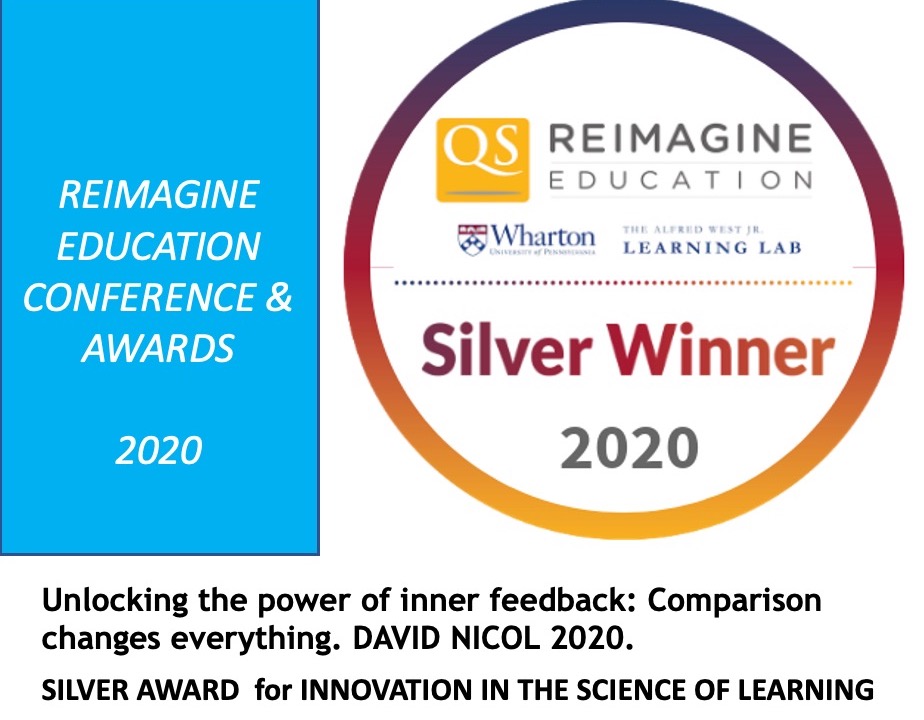The feedback problem
This website has relevance across all education. It addresses the problem of improving feedback on students' learning. It sees this problem as exisiting at two levels, a practical level and a deeper conceptual level. Practically, the problem is that:
-
§ students are often dissatisfied with the quality, quantity and frequency of feedback available to them
-
§ teachers find providing detailed and tailored feedback burdensome, especially for large student numbers
-
§ feedback processes are not always effective especially in helping students develop higher order thinking and life-skills
-
§ students, especially weaker students, become more dependent on teachers the more feedback they receive.
Conceptually, the deeper problem is how we frame feedback. In everyday language, feedback constitutes comments teachers or others provide on students’ work. This framing suggests that comments are the main or primary source of feedback information. This frames teachers as responsible for feedback provision and this, in turn, disempowers students as the architects of their own feedback processes. As a result, any increase in feedback quality, quantity or frequency, increases teacher workload, especially if teachers are conscientious and student numbers large. For decades, researchers have tried to solve these problems using technology-supported feedback, audio- feedback, whole-class feedback, feedback requesting, peer feedback etc. However, none of these approaches has been successful because of the conception of feedback underpinning them. What follows is based on the re-conceptualisation of feedbaack as proposed in "The power of internal feedback: Exploiting natural comparison processes" (Nicol, (2020).
Students are generating feedback all the time
This solution starts from the premise that students are always generating feedback. They do this by comparing current knowledge against external information. Musicians learn to be better musicians by comparing their compositions and performances against those of other musicians. Scientists learn by comparing their models, methods and findings against those of others in peer-reviewed publications. Students use information from multiple sources for feedback generation (e.g. from textbooks, online resources, videos). Teacher comments only represent a drop in the ocean of information students use for feedback generation.
The key to unlocking the power of internal feedback is for teachers to have students turn some natural comparisons some are already making anyway into formal and explicit comparisons and also to design new resources for comparison. Having students explicate the feedback they generate in writing, discussion and action is crucial to this approach and to the development of students’ self-feedback capacity. This not only builds students metacognition and their self-regulatory capacity but teachers also learn what comments students really need and can adapt their input accordingly.
This approach addresses problems raised when feedback is conceptualised as comments. Staging different comparisons across a task or course does not increase teachers’ long-term workload, as comparison resources are reusable. Also, teachers can select comparators that help students generate feedback in known areas of conceptual difficulty or to promote their higher-order reasoning. The potential is vast and this approach might be equally applied to graduate attribute development which also rests on processes of comparison.
How does this differ from other feedback approaches?
There is almost no literature positing feedback as underpinned by comparison processes (Nicol, 2020). This is surprising given the extensive research showing that comparison underpins all major cognitive functions (e.g. memory, categorisation, evaluation) including higher-order reasoning. There are none, as far as I know, direct studies of feedback based on this comparison conception, although some researchers have carried out studies that when reinterpreted offer powerful support for it and provide some clear ideas for its implementation (e.g. Lipnevich et al, 2014; Anders et al, 2007)
Identifying comparison as its core mechanism transforms the way we think about feedback. It suggests we build on natural feedback processes that all learners (and indeed all humans) are engaging in and that we enhance them based on a simple and intervention methodology that applies across all disciplines.
Another merit of this conceptual re-framing is that it re-connects informal and formal feedback processes in mutually reinforcing and authentic ways. Until now these have been separated in the literature and in practice. For example, in educational settings, it is easy to identify situations where comparisons might happen implicitly in almost any teaching situation (e.g. when student groups present their findings after doing the same project). All teachers need to do is to harness their pedagogical power. What teachers need to do is to have students consciously make these comparisons and articulate and apply the learning that results. Students should also be invited to identify comparisons themselves. This builds students metacognitive knowledge and their capacity for self-regulation of learning.

